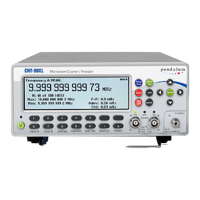Worst case
systematic error
Systematic trigger level timing
The calculations above show the typical un-
certainties in the constituents that make up the
total systematic error. For a given set of input
signals you can compensate for this error
more or less completely by making
calibration measurements. Depending on the
acceptable residual error, you can use one of
the methods described below. The first one is
very simple but does not take the
inter-channel propagation delay difference
into account. The second one includes all
systematic errors, if it is carried out
meticulously, but it is often not practicable.
Common
settings for the two inputs are:
Slope:
Coupling:
Impedance:
Pos or Neg
AC
1 M
or 50
depending on
source and frequency
Trigger:
Trigger Level:
Filter:
Method 1:
Connect the test signals to Input A and Input
B. Select the function Phase A rel A to find
the initial error. Use the MATH/LIM menu to
enter this value as the constant L in the for-
mula K*X+L by pressing X0 and change sign.
Now the current measurement result (X0) will
be subtracted from the future phase measure-
ments made by selecting Phase A rel B.A
considerable part of the systematic
phase er-
rors will thus be cancelled out. Note that this
calibration has to be repeated if the
frequency or the amplitude changes.
Method 2:
Connect one of the signals to be measured to
both Input A and Input B via a 50 power
splitter or a BNC T-piece, depending on the
source impedance. Make sure the cable
lengths between power splitter / T-piece and
instrument inputs are equal. Select the func-
tion
Phase A rel B and read the result. Enter
this value as a correction factor in the same
way as described above for Method 1.
In order to minimize the errors you should
also maintain
the signal amplitudes at the in-
puts, so that the deviation between
calibration and measurement is kept as small
as possible.
The same restrictions as for Method 1
regarding frequency and amplitude apply to
this method, i.e. you should recalibrate
whenever one of these signal parameters
changes.
Residual Systematic Error:
By mathematically (on the bench or in the
controller) applying corrections according to
one of the methods mentioned above, the
systematic error will be reduced, but not
fully eliminated. The residual time delay
error will most probably be negligible, but a
trigger level erro
r will always remain to a
certain extent, especially if the temperature
conditions are not constant.
USER MANUAL ●
CNT 9x Series ● Rev.22 February 2020

